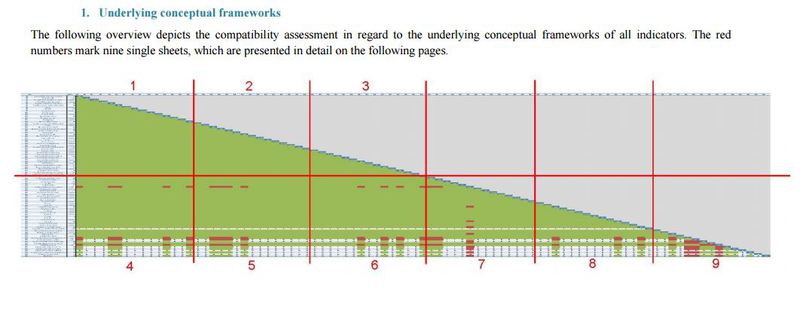D8.1 Impact models and aggregation
Aim and Objective
Deliverable D8.1 represents an intersection point between indicator documentation (WP7) and indicator exploration (WP8). The aim is to analyze the indicators documented in WP7 and determine to which degree they are compatible with one another in order to inform the development of tools for indicator exploration and aggregation (see MS34).
Deliverable D8.1 therefore needed to develop and apply a methodology which operationalizes the degree of compatibility between indicators. For this each of the 89 climate impactclimate impact
See Impact Assessment indicators compiled within the framework of D7.1 had to be analyzed in relation to all other indicators.
Results
Six determinants of indicator compatibility were identified. For each determinant the relevant issues were discussed and a suitable compatibility classification scheme was developed. For each determinant all climate impact indicators currently included in the indicator database of D7.1 were related to each other and assessed in regard to their degree of compatibility.
As of today the majority of fully documented pairs of indicators from D7.1 are compatible in regard to time periods, spatial extents, treatment of adaptive capacity, underlying scenariosscenarios
Scenarios can be thought of as stories of possible futures. They allow the description of factors that are difficult to quantify. In the context of climate change scenarios are used for the future development of factors such as governance, social structures, future population growth, technical development and agriculture. These descriptions are essential to model the future climate., data types and conceptual frameworks when considered separately. Of course mere compatibility between particular indicators does not necessarily mean that it makes sense to compare or combine them. Therefore, the results of D8.1 provide only a first basis for later on developing more in-depth guidance for users on how to meaningfully relate indicators to each other using the tools to be developed in WP8.
However, in total, most indicator pairs contained missing values because the D7.1 indicator database is still evolving. The compatibility assessment will therefore need to be updated at a later stage when the metadatametadata
Information about meteorological and climatological data concerning how and when they were measured, their quality, known problems and other characteristics. of D7.1 are more complete and the indicators and datasets developed within the CLIP-C consortium are included as well.

Deliverable D8.1 is a necessary preparatory step for the development of tools in Tasks 8.2 and 8.3. The methodology and preliminary results of the indicator compatibility assessment confirm the feasibility of comparing and combining climate impact indicators in these subsequent tasks. In the coming months the authors of D8.1 will need to work closely with WP7 concerning completion of the required metadata as well as WP5 and WP6 concerning metadata of the soon to be provided newly calculated indicators. On this basis a full update of the compatibility assessment is foreseen.